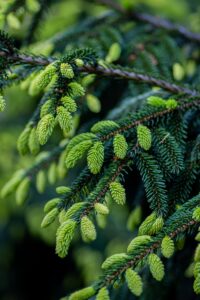Revised December 6, 2023
“Be attentive to any precautions around climate change, over-planted tree species and invasive pests that may impact your decisions. Don’t get too caught up in what looks good in the nursery, if it is not suited to your planting site. “
Planting a tree can provide many benefits to the environment and overall quality of life. Trees are typically divided into two main groups, deciduous and coniferous.
Trees breathe and they do a great job of pulling pollutants from the air, replacing carbon dioxide with oxygen. In the summer, all of our plants help to keep the air around us safer and cleaner. In the winter, while many trees and plants are hibernating, conifers continue their good work.
- Coniferous trees are considered to be evergreen, meaning they hold their needles throughout the year.
- Conifers offer many benefits to the homeowner including privacy, improved air quality, improved energy efficiency for the home, as well as overall beauty.
- Planting a hedge of Arborvitae in a sunny location can provide years of screening and privacy – a natural fence.
- Because conifers retain their needles, they work through the winter to help improve the air quality around your home. When planted on the north side of the home. they can also add the benefit of winter protection from chilly wind.
- Generally, planting coniferous trees about 15 – 20 apart is ideal. Give them room to breathe!
Choosing the right tree for the right location requires deliberate forethought. Keep in mind that native species from your area will most likely thrive better than some of the non-natives. Native trees are also beneficial to insects, butterflies and bees.
Coniferous trees native to Minnesota include:
- Balsam Fir
- Black SpruceEastern Larch (Tamarack)
- Eastern White Pine
- Jack Pine
- White Spruce
- Cedar (Red and White Cedar)
- Hemlock
The University of Minnesota and MN Department of Natural Resources have many resources to help guide you in tree selection, care and maintenance. They suggest planting trees native to Minnesota for best results. Take into consideration climate change and Zone 4 when making your decision.
What you can do:
- Be deliberate about the tree you purchase and where it will be placed: Not too close to structures, streets, other trees, property lines or under wires.
- Be aware of tree varieties that are vulnerable to disease, pests and climate change-nurseries will not warn you about this.
- Learn more here: https://extension.umn.edu/find-plants/trees-and-shrubs and https://www.dnr.state.mn.us/treecare/righttree-shrub.html
Was this post useful?
Average rating 5 / 5. Vote count: 3
No votes so far! Be the first to rate this post.












